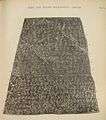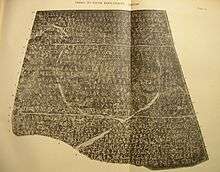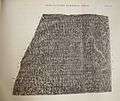Edicts of Ashoka


The Edicts of Ashoka are a collection of 33 inscriptions on the Pillars of Ashoka as well as boulders and cave walls made by the Emperor Ashoka of the Mauryan Empire during his reign from 269 BCE to 232 BCE. These inscriptions were dispersed throughout the areas of modern-day Bangladesh, India, Nepal, Afghanistan and Pakistan and represent the first tangible evidence of Buddhism. The edicts describe in detail the Ashoka's view about dhamma, an earnest attempt to solve some of problems that a complex society faced. According to the edicts, the extent of Buddhist proselytism during this period reached as far as the Mediterranean, and many Buddhist monuments were created.
The Edicts are divided into:
- Pillar Edicts
- Major Rock Edicts: 14 Edicts (termed 1st to 14th) and 2 separate ones found in Odisha
- Major Rock Inscriptions: Minor Rock Edicts, the Queen's Edict, Barabar Caves inscriptions and the Kandahar bilingual inscription.
These inscriptions proclaim Ashoka's adherence to the Buddhist philosophy which, as in Hinduism is called dharma, "Law". The inscriptions show his efforts to develop the Buddhist dharma throughout his kingdom. Although Buddhism and the Gautama Buddha are mentioned, the edicts focus on social and moral precepts rather than specific religious practices or the philosophical dimension of Buddhism.
In these inscriptions, Ashoka refers to himself as "Beloved of the Gods" (Devanampiyadasi) The identification of Devanampiyadasi with Ashoka was confirmed by an inscription discovered in 1915 by C. Beadon, a British gold-mining engineer, at Maski, a village in Raichur district of Karnataka. Another minor rock edict is found at the village Gujarra in Datia district of Madhya Pradesh. This also shows the name "Ashoka" in addition to usual "Devanampiyadasi". The inscriptions found in the eastern part of India were written in Magadhi Prakrit using the Brahmi script. These edicts were deciphered by British archaeologist and historian James Prinsep.
The inscriptions revolve around a few recurring themes: Ashoka's conversion to Buddhism, the description of his efforts to spread Buddhism, his moral and religious precepts, and his social and animal welfare program.
Ashoka's proselytism
In order to propagate the Buddhist faith, Ashoka explains that he sent emissaries to the Hellenistic kings as far as the Mediterranean, and to people throughout India, claiming they were all converted to the Dharma as a result. He names the Greek rulers of the time, inheritors of the conquest of Alexander the Great, from Bactria to as far as Greece and North Africa, displaying a clear grasp of the political situation at the time.
Proselytism beyond India

Now it is conquest by Dhamma that Beloved-of-the-Gods considers to be the best conquest. And it [conquest by Dhamma] has been won here, on the borders, even six hundred yojanas away, where the Greek king Antiochos rules, beyond there where the four kings named Ptolemy, Antigonos, Magas and Alexander rule, likewise in the south among the Cholas, the Pandyas, and as far as Tamraparni. Rock Edict Nb13 (S. Dhammika)
The distance of 600 yojanas corresponds to the distance between the center of India and Greece, roughly 4,000 miles.
- Amtiyoko refers to Antiochus II Theos of Syria (261–246 BCE), who controlled the Seleucid Empire from Syria to Bactria in the east from 305 to 250 BCE, and was therefore a direct neighbor of Ashoka.
- Turamaye refers to Ptolemy II Philadelphos of Egypt (285–247 BCE), king of the dynasty founded by Ptolemy I, a former general of Alexander the Great, in Egypt.
- Amtikini refers to Antigonus II Gonatas of Macedon (278–239 BCE).
- Maka refers to Magas of Cyrene (300–258 BCE).
- Alikasudaro refers to Alexander II of Epirus (272–258 BCE).
In the Gandhari original Antiochos is referred to as "Amtiyoko nama Yona-raja" (lit. "The Greek king by the name of Antiokos"), beyond whom live the four other kings: "param ca tena Atiyokena cature 4 rajani Turamaye nama Amtikini nama Maka nama Alikasudaro nama" (lit. "And beyond Antiochus, four kings by the name of Ptolemy, the name of Antigonos, the name of Magas, the name Alexander"
It is not clear in Hellenic records whether these emissaries were actually received, or had any influence on the Hellenic world. Some scholars, however, point to the presence of Buddhist communities in the Hellenistic world from that time, in particular in Alexandria (mentioned by Clement of Alexandria). The pre-Christian monastic order of the Therapeutae may have drawn inspiration for its ascetic lifestyle from contact with Buddhist monasticism, although the foundation and Scriptures were Jewish. Buddhist gravestones from the Ptolemaic period have also been found in Alexandria, decorated with depictions of the Wheel of the Law.[2] Commenting on the presence of Buddhists in Alexandria, some scholars have even pointed out that "It was later in this very place that some of the most active centers of Christianity were established" (Robert Linssen).
Ashoka’s proselytism also expanded to the south of the Indian subcontinent: The Cholas and Pandyas were south Indian peoples living outside Ashoka's empire.
Proselytism within Ashoka's territories
Inside India proper, in the realm of Ashoka, many different populations were the object of the King’s proselytism:
Here in the king's domain among the Greeks, the Kambojas, the Nabhakas, the Nabhapamkits, the Bhojas, the Pitinikas, the Andhras and the Palidas, everywhere people are following Beloved-of-the-Gods' instructions in Dhamma. Rock Edict Nb13 (S. Dhammika)
Greek communities
Greek communities lived in the northwest of the Mauryan empire, in the region of Pakistan, notably ancient Gandhara near the Pakistani capital of Islamabad, and in southern Afghanistan in the region of Gedrosia, following the conquest and the colonization efforts of Alexander the Great around 323 BCE. These communities therefore seem to have been still significant during the reign of Ashoka. A notable mention references aspects of Greek society.
There is no country, except among the Greeks, where these two groups, Brahmans and ascetics, are not found, and there is no country where people are not devoted to one or another religion. Rock Edict Nb13 (S. Dhammika)

Two edicts in Afghanistan have been found with Greek inscriptions, one of these being a bilingual edict in Greek language and Aramaic. This edict, found in Kandahar, advocates the adoption of "Piety" (using the Greek term Eusebeia for Dharma) to the Greek community:
Ten years (of reign) having been completed, King
Piodasses (one of the titles of Ashoka: Piyadassi or Priyadarsi, "He who is the beloved of the Gods and who regards
everyone amiably") made known (the doctrine of)
Piety (Greek:εὐσέβεια, Eusebeia) to men; and from this moment he has made
men more pious, and everything thrives throughout
the whole world. And the king abstains from (killing)
living beings, and other men and those who (are)
huntsmen and fishermen of the king have desisted
from hunting. And if some (were) intemperate, they
have ceased from their intemperance as was in their
power; and obedient to their father and mother and to
the elders, in opposition to the past also in the future,
by so acting on every occasion, they will live better
and more happily. (Trans. by G. P. Carratelli[3])
Other communities
- Kambojas are a people of Central Asian origin who had settled first in Arachosia and Drangiana (today’s southern Afghanistan), and in some of the other areas in the northwestern Indian subcontinent in Sindhu, Gujarat and Sauvira.
- The Nabhakas, the Nabhapamkits, the Bhojas, the Pitinikas, the Andhras and the Palidas are other people under Ashoka’s rule.
Moral precepts
The Dharma preached by Ashoka is explained mainly in term of moral precepts, based on the doing of good deeds, respect for others, generosity and purity.
Right behaviour
Dharma is good, but what constitutes Dharma? (It includes) little evil, much good, kindness, generosity, truthfulness and purity. Pilar Edict Nb2 (S. Dharmika)
And noble deeds of Dharma and the practice of Dharma consist of having kindness, generosity, truthfulness, purity, gentleness and goodness increase among the people. Rock Pilar Nb7 (S. Dharmika)
Benevolence
Ashok's Dharma meant that he used his power to try to make life better for his people and he also tried to change the way people thought and lived.
Kindness to prisoners
Ashoka showed great concern for fairness in the exercise of justice, caution and tolerance in the application of sentences, and regularly pardoned prisoners.
It is my desire that there should be uniformity in law and uniformity in sentencing. I even go this far, to grant a three-day stay for those in prison who have been tried and sentenced to death. During this time their relatives can make appeals to have the prisoners' lives spared. If there is none to appeal on their behalf, the prisoners can give gifts in order to make merit for the next world, or observe fasts. Pilar Edict Nb4 (S. Dhammika)
In the twenty-six years since my coronation prisoners have been given amnesty on twenty-five occasions. Pilar Edict Nb5 (S. Dhammika)
Respect for animal life
The Mauryan empire was the first Indian empire to unify the country and it had a clear-cut policy of exploiting as well as protecting natural resources with specific officials tasked with protection duty. When Ashoka embraced Buddhism in the latter part of his reign, he brought about significant changes in his style of governance, which included providing protection to fauna, and even relinquished the royal hunt. He was perhaps the first ruler in history to advocate conservation measures for wildlife. Reference to these can be seen inscribed on the stone edicts.[4]
Twenty-six years after my coronation various animals were declared to be protected – parrots, mainas, aruna, ruddy geese, wild ducks, nandimukhas, gelatas, bats, queen ants, terrapins, boneless fish, vedareyaka, gangapuputaka, fish, tortoises, porcupines, squirrels, deer, bulls, okapinda, wild asses, wild pigeons, domestic pigeons and all four-footed creatures that are neither useful nor edible. Those nanny goats, ewes and sows which are with young or giving milk to their young are protected, and so are young ones less than six months old. Cocks are not to be caponized, husks hiding living beings are not to be burnt and forests are not to be burnt either without reason or to kill creatures. One animal is not to be fed to another.— Edict on Fifth Pillar
The edicts also proclaim that many followed the king's example in giving up the slaughter of animals; one of them proudly states:
Our king killed very few animals.— Edict on Fifth Pillar[4]
Ashoka advocated restraint in the number that had to be killed for consumption, protected some of them, and in general condemned violent acts against animals, such as castration.
However, the edicts of Ashoka reflect more the desire of rulers than actual events; the mention of a 100 'panas' (coins) fine for poaching deer in royal hunting preserves shows that rule-breakers did exist. The legal restrictions conflicted with the practices then freely exercised by the common people in hunting, felling, fishing and setting fires in forests.[4]
Religious precepts
Buddhism

Beyond spreading the moral virtues of Buddhism, Ashoka also insisted that the word of the Buddha be read and followed, in particular in monastic circles (the Sanghas):
Piyadasi, King of Magadha, saluting the Sangha and wishing them good health and happiness, speaks thus: You know, reverend sirs, how great my faith in the Buddha, the Dhamma and Sangha is. Whatever, reverend sirs, has been spoken by Lord Buddha, all that is well-spoken. Minor Rock Edict Nb3 (S. Dhammika)
These Dhamma texts – Extracts from the Discipline, the Noble Way of Life, the Fears to Come, the Poem on the Silent Sage, the Discourse on the Pure Life, Upatisa's Questions, and the Advice to Rahula which was spoken by the Buddha concerning false speech – these Dhamma texts, reverend sirs, I desire that all the monks and nuns may constantly listen to and remember. Likewise the laymen and laywomen. Minor Rock Edict Nb3 (S. Dhammika)
Belief in a next world
One benefits in this world and gains great merit in the next by giving the gift of the Dhamma. Rock Edict Nb11 (S. Dhammika)
Happiness in this world and the next is difficult to obtain without much love for the Dhamma, much self-examination, much respect, much fear (of evil), and much enthusiasm. Pilar Edict Nb1 (S. Dhammika)
Religious exchange
Far from being sectarian, Ashoka, based on a belief that all religions shared a common, positive essence, encouraged tolerance and understanding of other religions.
All religions should reside everywhere, for all of them desire self-control and purity of heart. Rock Edict Nb7 (S. Dhammika)
Here (in my domain) no living beings are to be slaughtered or offered in sacrifice. Rock Edict Nb1 (S. Dhammika)
Contact (between religions) is good. One should listen to and respect the doctrines professed by others. Beloved-of-the-Gods, King Piyadasi, desires that all should be well-learned in the good doctrines of other religions. Rock Edict Nb12 (S. Dhammika)
Social and animal welfare
According to the edicts, Ashoka took great care of the welfare of his subjects (human and animal), and those beyond his borders, spreading the use of medicinal treatments, improving roadside facilities for more comfortable travel, and establishing "officers of the faith" throughout his territories to survey the welfare of the population and the propagation of the Dharma.
Medicinal treatments
Everywhere within Beloved-of-the-Gods, King Piyadasi’s domain, and among the people beyond the borders, the Cholas, the Pandyas, the Satiyaputras, the Keralaputras, as far as Tamraparni and where the Greek king Antiochos rules, and among the kings who are neighbors of Antiochos, everywhere has Beloved-of-the-Gods, King Piyadasi, made provision for two types of medical treatment: medical treatment for humans and medical treatment for animals. Wherever medical herbs suitable for humans or animals are not available, I have had them imported and grown. Wherever medical roots or fruits are not available I have had them imported and grown. Along roads I have had wells dug and trees planted for the benefit of humans and animals. Rock Edict Nb2 (S. Dhammika)
Roadside facilities
Along roads I have had banyan trees planted so that they can give shade to animals and men, and I have had mango groves planted. At intervals of eight krosas, I have had wells dug, rest-houses built, and in various places, I have had watering-places made for the use of animals and men. But these are but minor achievements. Such things to make the people happy have been done by former kings. I have done these things for this purpose, that the people might practice the Dhamma. Pilar Edict Nb7 (S. Dhammika)
Officers of the faith
In past there were no Dhamma Mahamatras but such officers were appointed by me thirteen years after my coronation. Now they work among all religions for the establishment of Dhamma, for the promotion of Dhamma, and for the welfare and happiness of all who are devoted to Dhamma. They work among the Greeks, the Kambojas, the Gandharas, the Rastrikas, the Pitinikas and other peoples on the western borders. They work among soldiers, chiefs, Brahmans, householders, the poor, the aged and those devoted to Dhamma – for their welfare and happiness – so that they may be free from harassment. Rock Edict Nb5 (S. Dhammika)
Estampages of Girnar Edicts
An estampage is an impression of the inscription on a rock face. This can be obtained by pressing wet paper to the rock face. Estampages of Ashokan edicts were prepared by ASI for their publication in a revised Corpus.[5]
The following five images are estampages of the Girnar Rock Edicts.
See also
- List of Edicts of Ashoka
- Pillars of Ashoka
- Ashokan Edicts in Delhi
- Ashoka's Major Rock Edict
- Edict
- Greco-Buddhism
- Kambojas
Notes
References
- ↑ Reference: "India: The Ancient Past" p.113, Burjor Avari, Routledge, ISBN 0-415-35615-6
- ↑ Tarn, "The Greeks in Bactria and India", Cambridge, Eng. University Press, 1951
- ↑ Mauryans & Graeco-Bactrians Archived July 15, 2006 at the Wayback Machine
- 1 2 3 Rangarajan, M. (2001) India's Wildlife History, pp 8.
- ↑ Corpus Inscriptionum Indicarum – Volume 1: Inscriptions of Ashoka by E. Hultzsch, 1925
Further reading
- Cunningham, Alexander (1877). Inscriptions of Asoka, Calcutta : Office of the Superintendent of Government Printing
- Dhammika, S. (1993). "The Edicts of King Asoka: An English Rendering", The Wheel Publication No. 386/387, Kandy Sri Lanka: Buddhist Publication Society, ISBN 955-24-0104-6
- Gombrich, Richard; Guruge, Ananda (1994). King Ashoka and Buddhism: Historical and Literary studies, Kandy: Sri Lanka; Buddhist Publication Society, 1st edition, ISBN 9552400651
- Mookerji, Radhakumud (1962). Aśoka (3rd ed.). Delhi: Motilal Banarsidas.
- Robert Linssen, "Zen living", ISBN 0-8021-3136-0
- Singh, Upinder (2008). "Chapter 7: Power and Piety: The Maurya Empire, c. 324-187 BCE". A History of Ancient and Early Medieval India: From the Stone Age to the 12th Century. New Delhi: Pearson Education. ISBN 978-81-317-1677-9.
External links
| Wikimedia Commons has media related to Edicts of Ashoka. |
- The Edicts of King Ashoka by Dhammika
- Edicts in original Gandhari
- Inscriptions of India – Complete listing of historical inscriptions from Indian temples and monuments
- Ashoka Library in Bibliotheca Polyglotta with all inscriptions, Māgadhī and English




